#Sumer
Explore tagged Tumblr posts
Text
Sorry nofap guys, but civilization was built by gooners (and sodomites?).

292 notes
·
View notes
Text
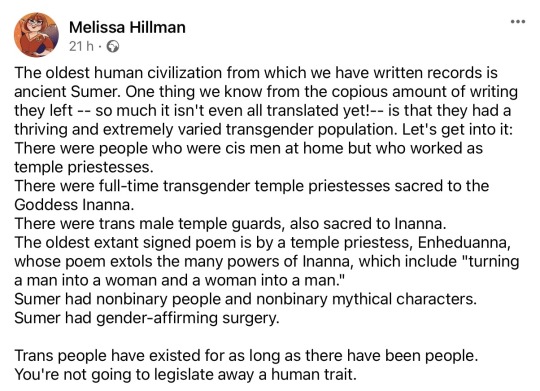
EDITED TO ADD: Sources from the OP in the comments
#trans#nonbinary#trans nonbinary#ancient history#sumer#gender#we have always been here#historical trans people#you cannot legislate us away and you cannot wipe us out while humanity still exists#we are as perennial as the grass#inanna#trans is sacred
54K notes
·
View notes
Text

The Golden Lyre of Ur, from the Royal Cemetery of Ur, Sumerian, circa 2550-2450 BC
Housed at the National Museum of Iraq
2K notes
·
View notes
Text

Iridescent silicious glass jar from Nippur
Ur III period, Neo-Sumerian, c. 2112-2004 B.C.
Al-Qādisiyyah Governorate, Iraq
503 notes
·
View notes
Text
“Sargon developed this new form of governance by conquering all the Sumerian cities of Mesopotamia, creating what most historians call the first empire in the world.” He added that, until these latest excavations, information on that empire was limited to fragmentary and bombastic royal inscriptions or much later copies of Akkadian inscriptions “which are not completely reliable”. Of the new discovery, he said: “It is extremely important because, for the first time, we have concrete evidence – with artefacts in situ.” He has been astonished by the detail in those records: “They note absolutely everything down. If a sheep dies at the very edge of the empire, it will be noted. They are obsessed with bureaucracy.” The tablets, containing cuneiform symbols, an early writing system, record affairs of state, deliveries and expenditures, on everything from fish to domesticated animals, flour to barley, textiles to precious stones. Dana Goodburn-Brown, a British-American conservator, is cleaning the tablets so that they can be transcribed. The work is both painstaking and exciting, she said: “People just think things come out of the ground and look like you see them in the museum, but they don’t.” One tablet lists different commodities: “250 grams of gold / 500 grams of silver/ … fattened cows… / 30 litres of beer.” Even the names and professions of the citizens are recorded, Rey said: “Women, men, children – we have names for everyone. “Women held important offices within the state. So we have high priestesses, for example, although it was a society very much led by men. But the role of the woman was at least higher than many other societies, and it’s undeniable based on the evidence that we have.” The jobs listed range from stone-cutters to the sweeper of the temple floor. Rey said: “Being able to sweep the floor where the gods and the high priest were located was very important. The cities of ancient Mesopotamia in theory all belonged to the gods. The society worked for the temple state.” The tablets were found at the site of a large state archive building, made of mud-brick walls and divided into rooms or offices. Some of the tablets contain architectural plans of buildings, field plans and maps of canals.
15 March 2025
171 notes
·
View notes
Text

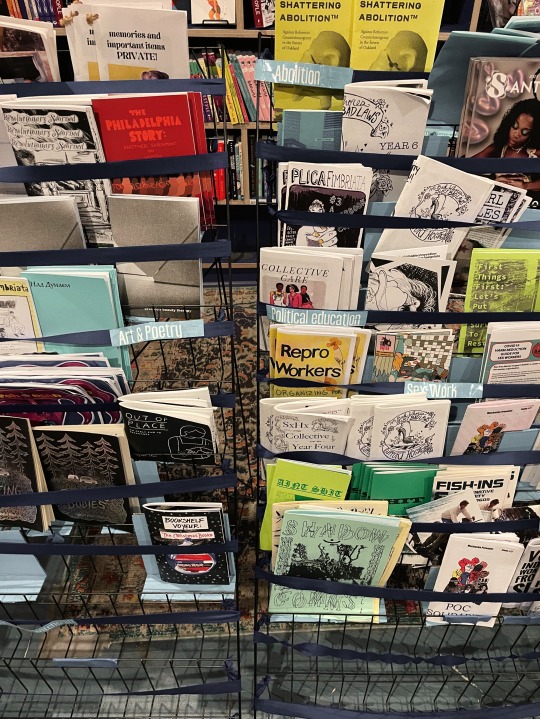
So many amazing bookshops in Manhattan, but one of my favourites is the worker-owned and radically compassionate Bluestockings Cooperative
#books#bookblr#booklr#bookshops#travel#travelgram#travelspo#zines#city#sumer#new york#nyc#new york city#manhattan#studyblr#studygram#studyspo#studying
1K notes
·
View notes
Text

Lamassu and Apsasu family ^^
#artists on tumblr#original#assyria#mesopotamia#Sumer#akkadian#lamassu#Apsasu#ancient world#misiuszko#illustration
97 notes
·
View notes
Text



Mesopotamian deities Ningirsu ( war ,agriculture, hypostasis of Ninurta, though it's not agreed if they were in origin two separate deities who were syncretized or the same god to begin ) and Nanshe (water, fish, birds, dream interpretation and justice) , top rank siblings in the local pantheon of the kingdom of Lagash ,which was proeminent in the Early Dynastic Period. Ningirsu was the patron god of the state as a whole.
Nanshe is a fan of birds, Ningirsu likes when armed forces of the kingdom of Umma get out of his (status hotly debated. Umma's god Shara would disagree) beloved field.
103 notes
·
View notes
Text
I may not have a phd in assyriology yet, but I'm already a professor in the arts of fujoshery

#i just know some ancient ass bitch in mesopotamia would go apeshit over this#i ordered some more keychains!! ill put a little cow that ill pretend its a bull#got this idea from a moot who did one of those for shirley maclaine 🫶 shout out to this bestie who has the universe on her brain 🥂✨#i should do one of those for nijinsky fr#gilkidu#epic of gilgamesh#gilgamesh#enkidu#bronze age#mesopotamia#sumer#gayass shit#terezaposting#had to edit cuz i accidentaly tagged this post as gilmore girls
68 notes
·
View notes
Text

Happy Birthday, Wanderer !!! ˚₊·—̳͟͞͞-`♡
#wanderer#genshin impact#anime#manga#fanart#genshin fanart#genshin impact wanderer#genshin wanderer#kunikuzushi#scaramouche#scara#genshin scaramouche#inazuma#sumer#anemo#anemo boys#hbd
419 notes
·
View notes
Text

Bearded Bull’s Head. Sumerian. 2600-2400 BCE.
Saint Louis Art Museum.
#sumerian#sumeria#Sumer#ancient history#ancient culture#history#Art#culture#sculpture#animals in art
72 notes
·
View notes
Text

#mesopotamia#sumerian#Sumer#history#mythology#Bronze Age#Ishtar#Gilgamesh#the epic of gilgamesh#epic of gilgamesh#John waters#divine#divine drag queen#pink flamingos
199 notes
·
View notes
Text

Sumerian Miku
ḫāzune mīku kalāmak
𒄩𒍪𒉈 𒈪𒆪 𒌦𒀝
©️ 𒀭𒀹𒁯 2024
#vocaloid#hatsune miku#miku#miku worldwide#miku world tour#art#digital art#illustration#digital illustration#sumer#babylon#ishtar#babylonian#cuneiform
139 notes
·
View notes
Photo

A map illustrating the earliest stages of human civilization spanning from c. 8000 BCE to 2000 BCE. It showcases the emergence of organized societies, agricultural practices, and the origins of urbanization.
62 notes
·
View notes
Text

I tried drawing ancient Sumerian Miku! I like how it turned out but I don't think it looks like Miku very much 💀
I'm no historian or even history nerd... So don't trust this to be very historically accurate lol. I mostly based this on Google searching and ancient Sumerian statuettes.
I'll put some more details under the cut:
I tried to write Hatsune Miku in Sumerian cuneiform... 𒄩𒌅𒉈𒊩𒆬 was what I came up with, hopefully it says something like "ha-tu-ne-mi-ku". In the image it's rotated 90°, because allexamples I could find of Sumerian language written in vertical columns where written in this manner. To find the right characters I used the Pennsylvania Sumerian Dictionary website... only to realize that Wikipedia had a convenient table all along... oh well.


The clothing she wears is called kaunakes, you can see it often in ancient Mesopotamia art, like the ones in these pictures. They were worn for a long time - you couldn't really narrow down my Miku to a specific time period... I didn't bother to make it accurate. 😅 Sorry folks.
The jewelry and hairstyle are based on the items found in the tomb of Puabi, and reconstructions of how they might've been worn by Puabi or her attendants (who were buried with her).


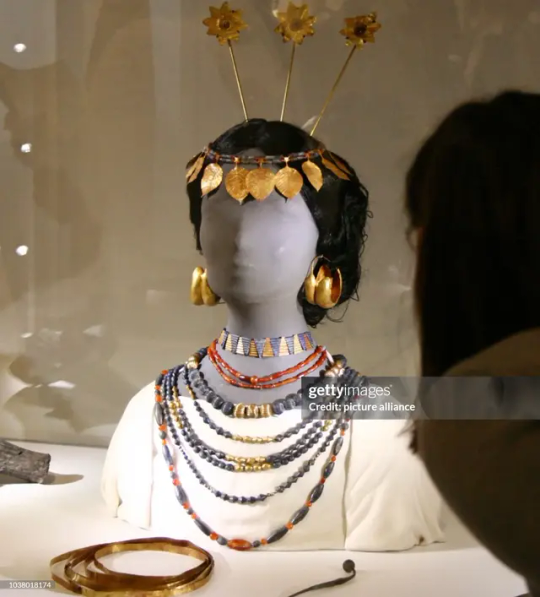
I didn't want to draw the fancy headress so I went for the simpler options 😅


She's holding a cup and something like a date palm spathe, which is a word I only learned while trying to find out what these figures are holding... most websites I saw described it as a palm frond, a whip or a date palm spathe.
For the background I just grabbed a public domain image with some cuneiform writing in it... I didn't really feel like drawing anything 😅
But I did like drawing this so maybe I'll make a series of ancient civilization inspired Mikus...
#hatsune miku#vocaloid#miku fanart#miku worldwide#miku world tour#sumer#sumerian#mesopotamia#my art#stuff i made
66 notes
·
View notes
Text
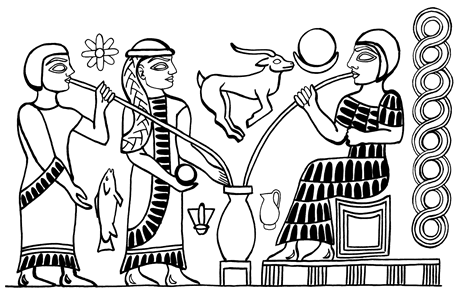
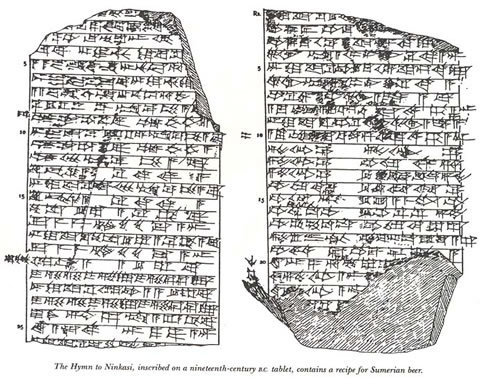

The Hymn of Ninkasi
The Ancient Sumerians loved their beer. In fact they loved their beer so much that thousands of years later ancient recipes and artwork depicting beer making and beer drinking survive to this day. Many of these recipes are being recreated and brewed thousands of years later by crafted breweries today. They drank it for ceremonial and religious reasons, they drank it for nutritional reasons, and they drank it for the same reasons we drink it today. You know ... to get pissed.
The Sumerians were so serious about their beer that they had their own deity devoted to the beverage named Ninkasi. Ninkasi was the goddess of beer and alcohol, who brewed the beverage daily to to “satisfy the desire�� and “sate the heart.” One of the earliest known devotions to Ninkasi was a hymn written on clay tablets dating to 1800 BC. Called “The Hymn to Ninkasi” it was more than just a devotional script or prayer, it was a recipe and procedure for brewing, written as a poem so that it would be easy to remember in an age when most people were illiterate. The beer that was produced was a very sweet beverage with around 3.5% alcohol by volume, created by brewing with malt and a twice baked honey bread (bappir) that had the taste and consistency of granola. It would have been very sweet compared to modern beer as the Sumerians lacked hops which gives the bitter flavors of beers today. Traditionally the beer was stored in clay pots and sipped using long drinking straws to filter out left over particulates.
The Hymn of Ninkasi
Borne of the flowing water, Tenderly cared for by the Ninhursag, Borne of the flowing water, Tenderly cared for by the Ninhursag, Having founded your town by the sacred lake, She finished its great walls for you, Ninkasi, having founded your town by the sacred lake, She finished it’s walls for you, Your father is Enki, Lord Nidimmud, Your mother is Ninti, the queen of the sacred lake. Ninkasi, your father is Enki, Lord Nidimmud, Your mother is Ninti, the queen of the sacred lake. You are the one who handles the dough [and] with a big shovel, Mixing in a pit, the bappir with sweet aromatics, Ninkasi, you are the one who handles the dough [and] with a big shovel, Mixing in a pit, the bappir with [date] - honey, You are the one who bakes the bappir in the big oven, Puts in order the piles of hulled grains, Ninkasi, you are the one who bakes the bappir in the big oven, Puts in order the piles of hulled grains, You are the one who waters the malt set on the ground, The noble dogs keep away even the potentates, Ninkasi, you are the one who waters the malt set on the ground, The noble dogs keep away even the potentates, You are the one who soaks the malt in a jar, The waves rise, the waves fall. Ninkasi, you are the one who soaks the malt in a jar, The waves rise, the waves fall. You are the one who spreads the cooked mash on large reed mats, Coolness overcomes, Ninkasi, you are the one who spreads the cooked mash on large reed mats, Coolness overcomes, You are the one who holds with both hands the great sweet wort, Brewing [it] with honey [and] wine (You the sweet wort to the vessel) Ninkasi, (…)(You the sweet wort to the vessel) The filtering vat, which makes a pleasant sound, You place appropriately on a large collector vat. Ninkasi, the filtering vat, which makes a pleasant sound, You place appropriately on a large collector vat. When you pour out the filtered beer of the collector vat, It is [like] the onrush of Tigris and Euphrates. Ninkasi, you are the one who pours out the filtered beer of the collector vat, It is [like] the onrush of Tigris and Euphrates.
321 notes
·
View notes